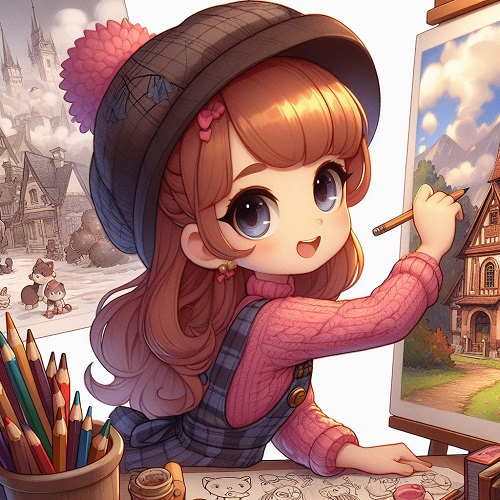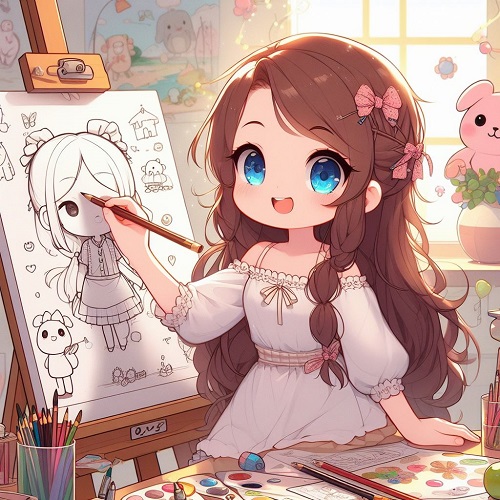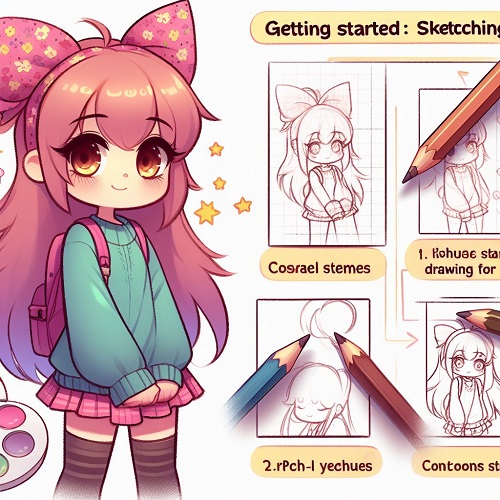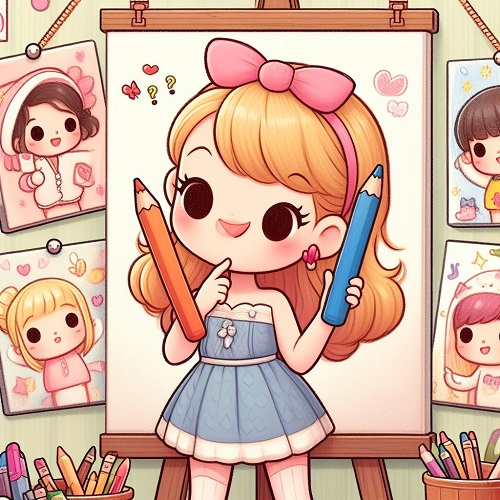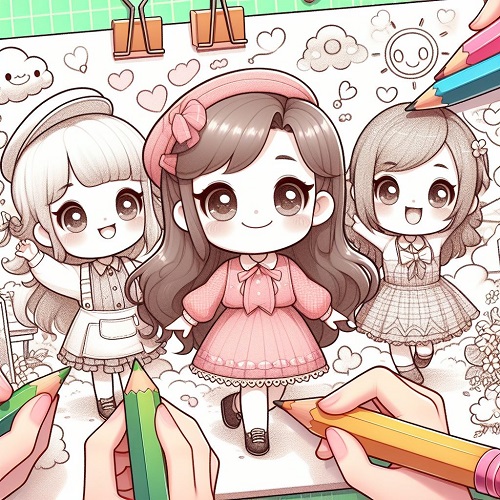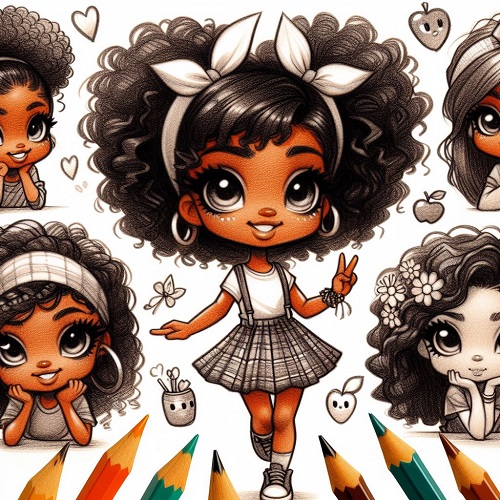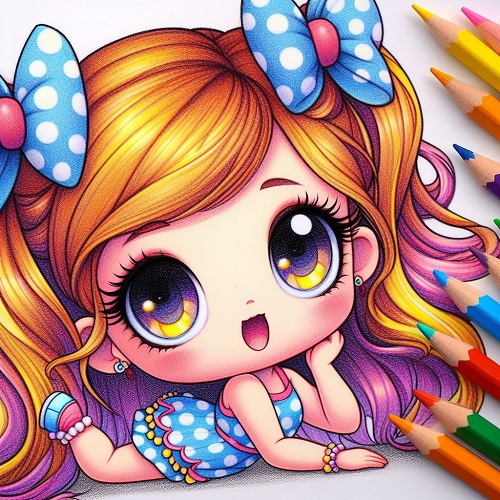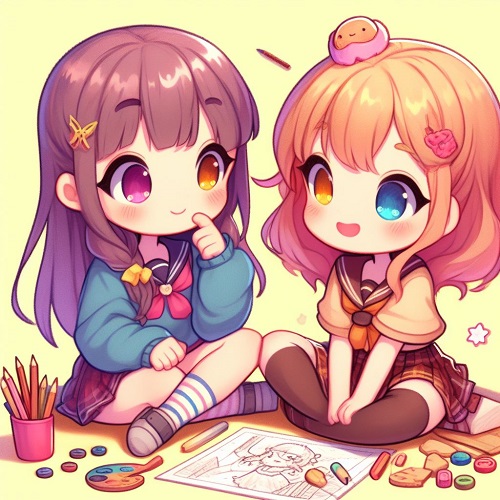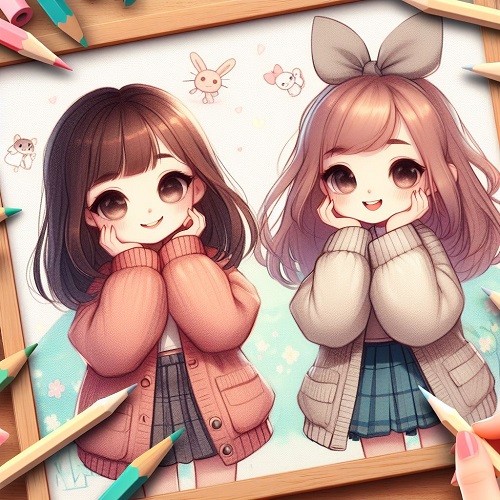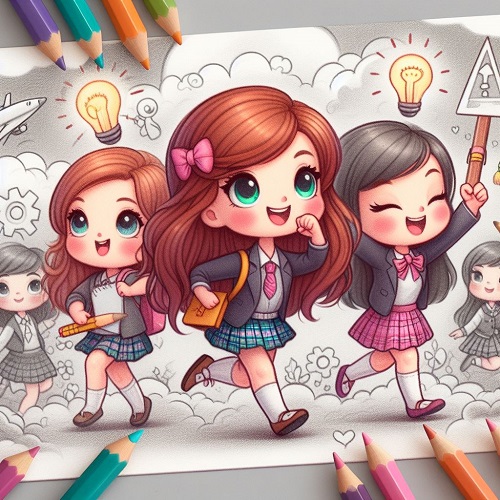Mastering the Art of Pencil Drawing on Canvas: Your Comprehensive Guide
Pencil drawing on canvas transcends traditional sketching, infusing life into your creations. In this comprehensive guide, we delve into the intricate world of pencil drawing on canvas, offering a rich tapestry of techniques, tips, and inspiration for both novice and seasoned artists.
I. The Basics of Pencil Drawing on Canvas
A. The Significance of Canvas as a Medium
Canvas, with its porous and textured surface, becomes a dynamic partner in the artistic journey. Its ability to absorb and hold pencil strokes contributes to the depth and character of your drawings. Explore the tactile relationship between pencil and canvas, understanding how the canvas’s grain influences your artistic expression.
FAQ: Why is canvas preferred for pencil drawing?
Canvas provides a unique texture that enhances the tactile quality of pencil drawings. Its absorbent nature allows for subtle shading and layering, contributing to the overall richness of the artwork.
B. Essential Pencil Drawing Supplies
The artist’s toolkit is the gateway to creative expression. Dive into the world of pencil grades, understanding how each grade contributes to shading, detailing, and the overall aesthetic of your drawings. Discover the importance of quality erasers and sketch pads, laying the foundation for a seamless creative process.
FAQ: Can I use any pencil for drawing on canvas?
While any pencil can be used, the varied grades offer different effects. A combination of H and B pencils allows for a wide range of shading and detailing in pencil drawing on canvas.
-
C. Setting Up Your Creative Workspace
Your creative space is the birthplace of inspiration. Explore practical tips for organizing your workspace, from proper lighting to ergonomic considerations. Understand how a well-thought-out workspace can enhance focus and elevate the quality of your pencil drawings on canvas.
FAQ: How does lighting impact pencil drawing on canvas?
Adequate lighting is crucial for accurate shading and detailing. Natural light or adjustable artificial lighting can help you see the nuances of your drawings clearly.
II. Getting Started: Sketching Techniques
-
A. Pencil Grades and Their Applications
Pencils, the extension of an artist’s hand, come in various grades, each with a unique purpose. Delve into the world of graphite, from the hard precision of H pencils to the soft, expressive strokes of B pencils. Understand how mastering pencil grades allows you to create intricate shading and capture the subtleties of your subject.
FAQ: Which pencil grade is best for detailed drawings on canvas?
B pencils (B4 to B8) are ideal for detailed drawings on canvas, allowing for controlled strokes while maintaining a level of softness for nuanced shading.
-
B. Creating Preliminary Sketches on Canvas
The canvas, a blank slate awaiting your artistic vision, comes to life with the initial sketches. Learn the art of light, gestural strokes that lay the groundwork for your composition. Discover techniques for building proportions and guiding the flow of your drawing.
FAQ: How do I avoid damaging the canvas during the sketching phase?
Use a light touch during the initial sketch to avoid pressing too hard. This ensures that the canvas remains receptive to subsequent layers of pencil work.
-
C. Achieving Proportion and Balance
The foundation of any great drawing lies in proportion and balance. Dive into techniques for accurately scaling your subjects, ensuring that elements harmonize within the composition. Learn how to use reference points to maintain balance, creating a visually appealing and cohesive artwork.
FAQ: What if my initial sketch is not proportionate?
Correcting proportions is a common part of the artistic process. Use erasers to gently adjust and refine your initial sketch until you achieve the desired balance.
III. Choosing the Right Canvas
-
A. Types and Textures of Canvas
Canvas, like a symphony of textures, offers a range of options for artistic exploration. From smooth surfaces to coarse textures, each canvas type introduces a unique dimension to your drawings. Explore the nuances of canvas textures and how they can enhance the visual impact of your artwork.
FAQ: How does canvas texture affect the final drawing?
The texture of the canvas impacts the appearance of your drawings. Smoother surfaces are ideal for intricate details, while coarser textures add character and depth to broader strokes.
-
B. Impact of Canvas Size
Size is a powerful compositional tool in pencil drawing on canvas. Delve into the considerations of small-scale intimate drawings versus large, expansive compositions. Understand how canvas size influences the level of detail and emotional resonance in your artwork.
FAQ: Can I use any size canvas for pencil drawing?
While any size can be used, larger canvases allow for more intricate details and provide a captivating space for expansive compositions.
-
C. Selecting the Best Canvas
Choosing the right canvas is a critical decision in the artistic process. From stretched canvases to canvas panels, each option has its merits. Gain insights into selecting the ideal canvas based on your artistic preferences and the nature of your subject.
FAQ: What canvas is best for detailed pencil drawings?
Canvas panels are often preferred for detailed pencil drawings as they provide a stable surface and are less prone to warping.
IV. Transferring Your Ideas to Canvas
-
A. Techniques for Transferring Sketches
The transition from sketch pad to canvas is a pivotal moment in the artistic process. Explore various transfer techniques, from traditional grid methods to modern projectors. Understand the advantages and limitations of each method to choose the one that best suits your artistic vision.
FAQ: Can I freehand my sketch directly onto the canvas?
While freehand drawing is possible, using transfer techniques ensures greater accuracy and allows you to focus on refining details rather than the initial layout.
-
B. Maintaining Sketch Integrity
Preserving the essence of your original sketch during the transfer process is crucial. Learn tips and tricks to ensure that the vitality and energy captured in your initial sketches are retained on the canvas. Discover how to avoid common pitfalls and challenges associated with transferring your ideas.
FAQ: How can I prevent smudging during the transfer process?
Lightly fixative your sketch with a workable fixative spray before transferring to minimize smudging while preserving the sketch’s integrity.
V. Pencil Techniques and Styles
-
A. Shading Techniques
Shading is the soul of pencil drawing, breathing life and dimension into your artwork. Explore various shading techniques, from hatching and cross-hatching to stippling and blending. Mastering these techniques allows you to create depth and form, transforming a two-dimensional canvas into a three-dimensional world.
FAQ: What is the difference between hatching and cross-hatching?
Hatching involves parallel lines, while cross-hatching uses intersecting lines to create shading. Cross-hatching provides a denser and more textured effect.
-
B. Texturing with Cross-Hatching and Stippling
Elevate your drawings by adding texture through cross-hatching and stippling. Understand how these techniques can simulate a variety of surfaces, from smooth skin to rough landscapes. Dive into the art of controlled mark-making to convey intricate details.
FAQ: How do I avoid overworking my drawing with cross-hatching?
Start with light strokes and gradually build up the density of lines. This ensures you maintain control over the level of texture and prevent overworking the drawing.
-
C. Experimenting with Pencil Styles
Pencil drawing on canvas is a realm of endless possibilities. Experiment with different pencil styles, from fine lines to bold strokes, to discover your unique artistic voice. Explore how varying pressure and stroke techniques can evoke different moods and atmospheres in your drawings.
FAQ: Can I mix different pencil styles in one drawing?
Absolutely! Mixing pencil styles adds visual interest and depth to your artwork. Use fine lines for intricate details and bold strokes for emphasis, creating a harmonious balance.
VI. Color in Pencil Drawings: A Creative Twist
-
A. Introduction to Colored Pencils
Introduce a burst of color into your pencil drawings by incorporating colored pencils. Learn the basics of color theory and discover how to choose a complementary color palette that enhances the mood and vibrancy of your artwork.
FAQ: Can I use any colored pencils for pencil drawings on canvas?
Quality colored pencils with strong pigments work best. Brands like Prismacolor or Faber-Castell are popular choices among artists for their vibrant colors and smooth application.
-
B. Blending and Layering Colors
Master the art of blending and layering colored pencils to achieve seamless transitions and rich hues. Explore techniques for creating gradients, shadows, and highlights, unlocking the full potential of color in your pencil drawings on canvas.
FAQ: How do I blend colored pencils without smudging?
Use a light touch when blending and layering colors. Additionally, consider using a colorless blender pencil to smooth transitions without smudging.
-
C. Combining Graphite and Colored Pencils
Embrace the dynamic synergy of graphite and colored pencils in a single artwork. Discover how combining these mediums can add complexity and visual interest to your drawings. Experiment with layering and blending techniques to achieve a harmonious integration of graphite and color.
FAQ: Can I use colored pencils over graphite on canvas?
Yes, you can! Start with the graphite base and layer colored pencils on top. The graphite provides a foundation for shading and detailing, while the colored pencils introduce vibrant tones.
VII. Common Challenges and How to Overcome Them
-
A. Addressing Common Mistakes
Every artist encounter challenges; it’s part of the creative journey. Identify common mistakes in pencil drawing on canvas, from smudging to proportion errors, and learn effective strategies to overcome them.
FAQ: How do I fix a mistake without ruining the entire drawing?
Act quickly! Use a kneaded eraser or a small brush to gently lift or erase the mistake. For more significant errors, consider incorporating the mistake into the artwork or starting over on a fresh canvas.
-
B. Smudging and Erasing Techniques
Smudging is an inevitable part of the drawing process, but there are ways to minimize its impact. Explore techniques for preventing smudging and learn how to use various erasers effectively to correct errors without compromising the quality of your drawing.
FAQ: What eraser is best for pencil drawings on canvas?
Kneaded erasers are versatile and ideal for pencil drawings on canvas. They lift graphite cleanly without damaging the surface, allowing for precise corrections.
-
C. Longevity of Pencil Drawings
Preserving your artwork for years to come requires attention to detail. Understand the factors that can impact the longevity of pencil drawings on canvas and learn practical tips for ensuring your creations withstand the test of time.
FAQ: How can I protect my pencil drawings from fading?
Consider framing your drawings with UV-protective glass to minimize exposure to sunlight, which can cause fading over time.
VIII. Showcasing Your Masterpieces
-
A. Proper Framing and Presentation
The final touch to your artistic journey is the framing and presentation of your masterpieces. Dive into the aesthetics of framing, exploring various styles and materials that complement your artwork. Learn how proper framing can enhance the visual impact of your pencil drawings on canvas.
FAQ: Should I frame my drawings myself or hire a professional?
It depends on your comfort level and the importance of the artwork. If unsure, seeking the expertise of a professional framer ensures your artwork is presented in the best possible way.
-
B. Photographing and Digitizing
In the digital age, sharing your artwork with a global audience is easier than ever. Explore tips for photographing your drawings to capture their true essence. Learn how to digitize your creations for online sharing while maintaining the integrity of your artwork.
FAQ: What camera settings are best for photographing pencil drawings on canvas?
Use natural light or soft, diffused artificial light to minimize shadows. Set your camera to a high resolution and use a tripod for stability to capture the fine details of your artwork.
-
C. Building an Artist’s Portfolio
Assemble a captivating portfolio that showcases the breadth and depth of your artistic journey. Learn the art of curating your work, creating a narrative that resonates with viewers and potential clients. Discover online platforms and strategies for gaining exposure in the vibrant art community.
FAQ: How do I build an online portfolio for my pencil drawings?
Choose a user-friendly platform like Behance or Instagram. Curate your portfolio with a mix of finished pieces, progress shots, and personal insights to engage your audience.
IX. Inspiring Success Stories
-
A. Renowned Artists in Pencil Drawing
Draw inspiration from the journeys of accomplished artists who have mastered the art of pencil drawing on canvas. Explore the diverse styles and techniques that have propelled these artists to recognition and discover how their stories can fuel your own creative growth.
FAQ: How can I connect with successful artists in the pencil drawing community?
Attend art events, workshops, and online forums. Engaging with the community provides opportunities to learn, share experiences, and gain valuable insights from successful artists.
-
B. Journeys and Techniques
Delve into the personal stories of these artists, unraveling the challenges they faced and the techniques they employed to overcome them. Gain valuable insights into the artistic process and discover how embracing challenges can lead to profound growth as an artist.
FAQ: How do I stay motivated during artistic challenges?
Surround yourself with a supportive community, set achievable goals, and celebrate small victories. Recognize that challenges are an integral part of the artistic journey, contributing to your growth as an artist.
-
C. Drawing Inspiration for Your Own Growth
As you explore the stories of successful artists, reflect on how their journeys can ignite your own creative flame. Learn to channel inspiration into your work, embracing challenges as opportunities for improvement. Discover how the collective experiences of the artistic community can enrich your own artistic narrative.
FAQ: How can I overcome creative blocks and find inspiration?
Take breaks, explore new subjects, and immerse yourself in different art forms. Inspiration often comes from unexpected places, so remain open to the world around you.
X. Conclusion
-
A. Summarizing Key Takeaways
Take a moment to reflect on the wealth of knowledge gained throughout this comprehensive guide. Summarize key takeaways, from mastering basic techniques to exploring advanced styles, and celebrate the progress made in your artistic journey.
FAQ: What is the most important lesson for a beginner in pencil drawing on canvas?
-
B. Embracing the Journey
Acknowledge that the journey of pencil drawing on canvas is a continuous exploration of creativity and self-expression. Encourage readers to savor the process, finding joy in each stroke and the evolution of their artistic voice. Embracing the journey ensures sustained passion and growth.
FAQ: How can I stay motivated to continue my artistic journey?
Set achievable goals, surround yourself with a supportive artistic community, and find inspiration in diverse art forms. Remember that each drawing is a step forward in your artistic evolution.
-
C. Inviting Comments and Sharing
Foster a sense of community by encouraging readers to share their experiences, insights, and creations in the comments section. Creating a dialogue allows artists to connect, exchange ideas, and form a supportive network.
FAQ: How can I receive constructive feedback on my artwork?
Engage with art communities online, join critique groups, and share your work with peers and mentors. Constructive feedback is invaluable for growth and improvement.
By delving into the nuances of pencil drawing on canvas, readers embark on a transformative journey that goes beyond the technical aspects. This comprehensive guide not only equips them with practical skills but also instills the mindset needed to navigate the challenges and celebrate the joys of artistic expression.
XI. Frequently Asked Questions (FAQs):
I. The Basics of Pencil Drawing on Canvas
- FAQ: Why is canvas preferred for pencil drawing?Canvas provides a unique texture that enhances the tactile quality of pencil drawings. Its absorbent nature allows for subtle shading and layering, contributing to the overall richness of the artwork.
- FAQ: Can I use any pencil for drawing on canvas?While any pencil can be used, the varied grades offer different effects. A combination of H and B pencils allows for a wide range of shading and detailing in pencil drawing on canvas.
- FAQ: How does lighting impact pencil drawing on canvas?Adequate lighting is crucial for accurate shading and detailing. Natural light or adjustable artificial lighting can help you see the nuances of your drawings clearly.
II. Getting Started: Sketching Techniques
- FAQ: Which pencil grade is best for detailed drawings on canvas?B pencils (B4 to B8) are ideal for detailed drawings on canvas, allowing for controlled strokes while maintaining a level of softness for nuanced shading.
- FAQ: How do I avoid damaging the canvas during the sketching phase?Use a light touch during the initial sketch to avoid pressing too hard. This ensures that the canvas remains receptive to subsequent layers of pencil work.
- FAQ: What if my initial sketch is not proportionate?Correcting proportions is a common part of the artistic process. Use erasers to gently adjust and refine your initial sketch until you achieve the desired balance.
III. Choosing the Right Canvas
- FAQ: How does canvas texture affect the final drawing?The texture of the canvas impacts the appearance of your drawings. Smoother surfaces are ideal for intricate details, while coarser textures add character and depth to broader strokes.
- FAQ: Can I use any size canvas for pencil drawing?While any size can be used, larger canvases allow for more intricate details and provide a captivating space for expansive compositions.
- FAQ: What canvas is best for detailed pencil drawings?Canvas panels are often preferred for detailed pencil drawings as they provide a stable surface and are less prone to warping.
IV. Transferring Your Ideas to Canvas
- FAQ: Can I freehand my sketch directly onto the canvas?While freehand drawing is possible, using transfer techniques ensures greater accuracy and allows you to focus on refining details rather than the initial layout.
- FAQ: How can I prevent smudging during the transfer process?Lightly fixative your sketch with a workable fixative spray before transferring to minimize smudging while preserving the sketch’s integrity.
V. Pencil Techniques and Styles
- FAQ: What is the difference between hatching and cross-hatching?Hatching involves parallel lines, while cross-hatching uses intersecting lines to create shading. Cross-hatching provides a denser and more textured effect.
- FAQ: How do I avoid overworking my drawing with cross-hatching?Start with light strokes and gradually build up the density of lines. This ensures you maintain control over the level of texture and prevent overworking the drawing.
VI. Color in Pencil Drawings: A Creative Twist
- FAQ: Can I use any colored pencils for pencil drawings on canvas?Quality colored pencils with strong pigments work best. Brands like Prismacolor or Faber-Castell are popular choices among artists for their vibrant colors and smooth application.
- FAQ: How do I blend colored pencils without smudging?Use a light touch when blending and layering colors. Additionally, consider using a colorless blender pencil to smooth transitions without smudging.
- FAQ: Can I use colored pencils over graphite on canvas?Yes, you can! Start with the graphite base and layer colored pencils on top. The graphite provides a foundation for shading and detailing, while the colored pencils introduce vibrant tones.
VII. Common Challenges and How to Overcome Them
- FAQ: How do I fix a mistake without ruining the entire drawing?Act quickly! Use a kneaded eraser or a small brush to gently lift or erase the mistake. For more significant errors, consider incorporating the mistake into the artwork or starting over on a fresh canvas.
- FAQ: What eraser is best for pencil drawings on canvas?Kneaded erasers are versatile and ideal for pencil drawings on canvas. They lift graphite cleanly without damaging the surface, allowing for precise corrections.
- FAQ: How can I protect my pencil drawings from fading?Consider framing your drawings with UV-protective glass to minimize exposure to sunlight, which can cause fading over time.
- Mastering the Art: A Comprehensive Guide to Pokemon Pencil Drawing
- Mastering the Art of Pencil Drawing on Canvas: Your Comprehensive Guide
- Unveiling Artistry: A Comprehensive Guide to Horse Pencil Drawings
- Mastering the Art of Pencil Drawing Cartoon Characters: A Comprehensive Guide
- Unleash Your Creativity: A Comprehensive Step-by-Step Guide to Colored Pencil Drawing
- Unleashing the Depths of Creativity: A Comprehensive Guide to Octopus Pencil Drawing
- Unlocking the Artistry: A Deep Dive into Black Pencil Drawing
- Mastering the Art of Tree Pencil Drawing: A Step-by-Step Guide for Aspiring Artists
- Dive into Creativity: The Magic of Underwater Pencil Drawing
- Unleashing Creativity: Mastering the Art of 2B Pencil Drawing

